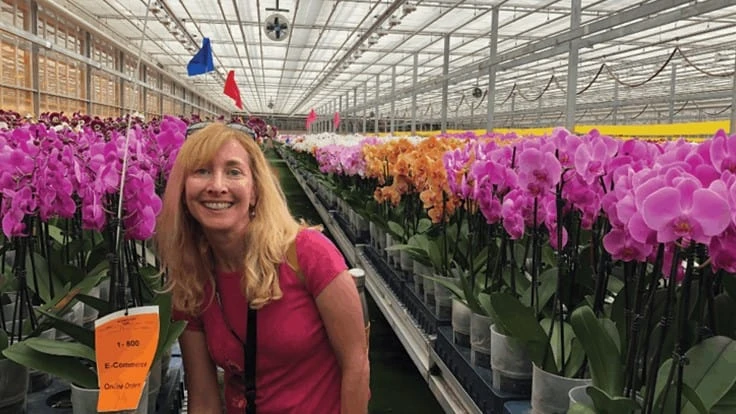

In 2005, right after Janna Beckerman accepted a position as an extension plant pathologist and botany professor at Purdue University, a group of apple growers contacted her about fungicide resistance. In the process of researching failing fungicides in apple trees, Beckerman became fascinated with the topic of fungicide resistance and dedicated her career to studying the issue.
Beckerman talked with Greenhouse Management about the problems with fungicide resistance, the latest research and what can be done in the greenhouse — and in the field — to help.
Greenhouse Management: What do we know now that we didn’t know when you started researching fungicide resistance?
Janna Beckerman: When I started, I don’t think we understood how much fungicide resistance was out there in the orchard because it is such a heavily chemically managed crop. Not only didn’t we understand how much fungicide resistance there was, we didn’t know that we were going to have to change our management options because we were running out of fungicides. At the same time, some of the disease-resistant genes that were discovered in the early 1900s were failing.
GM: Why is your research important to greenhouse growers?
JB: In the greenhouse, just like in an orchard, when you apply a fungicide repeatedly without [rotating chemicals] and you fail to perform good cultural controls and maintain proper environmental conditions and good sanitation, you will drive fungicide resistance.
We’ve done trials in the greenhouse [at Purdue University] to look at how well fungicides work and to see if there is fungicide resistance. Here in Indiana, we haven’t seen fungicide resistance like some of the bigger greenhouse bedding plant-producing states where they are working with larger populations and the plants are more intensely managed. But some of the resistances that we have seen in the greenhouse are Pythium aphanidermatum [a soil-borne pathogen that causes root and stem rots and damping off], Phytophthora nicotianae [a fungus that causes root, crows and fruit rot and leaf and stem infections] and Botrytis [a gray mold].
GM: How does this research translate to the field?
JB: I deal with a lot of landscapers and greenhouse growers who have applied fungicides and not had the level of control that they once did. It’s starting to be a problem with downy mildew on impatiens. Certain varieties [of impatiens] that were supposed to be resistant to downy mildew have become tolerant. Once we have fungicide resistance, it is a hard problem to solve.

GM: How can growers start to address fungicide resistance in the greenhouse?
JB: From a scientific perspective, not an economic perspective and not a greenhouse grower perspective … we should probably put a moratorium on plain old Impatiens walleriana. I say that because is it’s just so susceptible and it can generate such huge numbers of spores that it makes controlling the disease with fungicides all but impossible.
The middle ground would be instead of eliminating Impatiens walleriana, limiting the number of cutting-propagated impatiens and maybe going with seed and accept the fact that, yes, there will be more variability, but it’s the price you pay for less susceptibility. Using more of the disease-resistant impatiens like SunPatiens or even New Guinea impatiens [is beneficial].
GM: What role does extension play in addressing fungicide resistance?
JB: Extension provides impartial research-based information to help growers face business challenges. I have worked with growers figuring out how to fix the underlying water problems so their fungicides were more effective and helped growers develop better sanitation programs to reduce the number of infected plants and not propagate them to clean up their stock. In addition to the consulting piece, I also do research in [the onsite greenhouse at Purdue University], write newsletters to inform people that there’s new fungicides on the market, and we’ve even developed an app that growers can use to help their seasonal workers identify issues with their stock.
GM: What advice do you have for growers who are struggling with fungicide resistance issues in their greenhouses?
JB: When we’re working with something that is purportedly disease-resistant, it is not immune and you still have to manage for disease, otherwise you will eventually evolve a population that can infect your resistant variety. You have to rotate your chemicals and make sure to rotate with different modes of action so that if you are dealing with fungicide resistance, you’re hitting it with something that will kill it.
You really want to have a strong cultural foundation, too, making sure that you’re working with healthy plants, putting them through proper quarantine, using good sanitation, good watering practices, good fertilization practices and making sure you have the right media for the right plant. It isn’t a one-size-fits-all and that’s the same with fungicides; there are no solutions, there are only trade-offs, and doing the right thing usually means you’re going to have to put a lot more work into it.

Explore the February 2020 Issue
Check out more from this issue and find your next story to read.
Latest from Greenhouse Management
- Anthura acquires Bromelia assets from Corn. Bak in Netherlands
- Top 10 stories for National Poinsettia Day
- Langendoen Mechanical hosts open house to showcase new greenhouse build
- Conor Foy joins EHR's national sales team
- Pantone announces its 2026 Color of the Year
- Syngenta granted federal registration for Trefinti nematicide/fungicide in ornamental market
- A legacy of influence
- HILA 2025 video highlights: John Gaydos of Proven Winners





